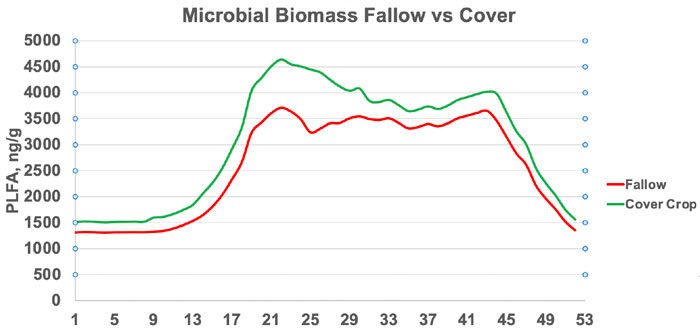No-Till Farmer
Get full access NOW to the most comprehensive, powerful and easy-to-use online resource for no-tillage practices. Just one good idea will pay for your subscription hundreds of times over.

BIOLOGICAL PRIMING EFFECT. The dip in the fallow field at week 25 on this graph illustrates the biological priming effect. Regen Ag Lab co-founder Lance Gunderson says the cover-cropped field has less of a dip because the covers are priming the soil biology for the cash crop. Source: Lance Gunderson
Lance Gunderson, co-founder and president of Regen Ag Lab in Pleasanton, Neb., looks at soil as a puzzle.
“If we knew exactly how the puzzle should be put together, it would be very simple,” Gunderson says. “But right now in ag, a lot of our soil testing is looking at only 12 or 15 pieces of a 1,000-piece puzzle, and it’s really hard to see what that picture’s supposed to look like, especially from an operational standpoint.”
Gunderson many years of experience with soil testing, and he’s a passionate believer in its ability to help farmers track progress on the farm.
Soil health can be measured via three broad categories: physical, chemical and biological properties. Soil physical qualities include texture, structure, porosity and pore size distribution, water retention and transmission and aeration. On the chemical side, soil tests look at factors like nitrates, phosphates, reactions and cation exchange capacity (CEC). Soil biological qualities include soil biodiversity, soil organic carbon, pests and pathogens, and microbial biomass.
Gunderson says it’s critical for farmers to set goals before they begin the soil testing process. This helps avoid testing for anything and everything, which can quickly become expensive. Goals can include reducing input costs, improving water retention, weed control and improving work-life balance on the farm.
“Figure out what your goals are, and then identify your resource concerns,” Gunderson says. “No matter if your primary issue is weed pressure or drought or Goss’s wilt year after year when you plant corn…